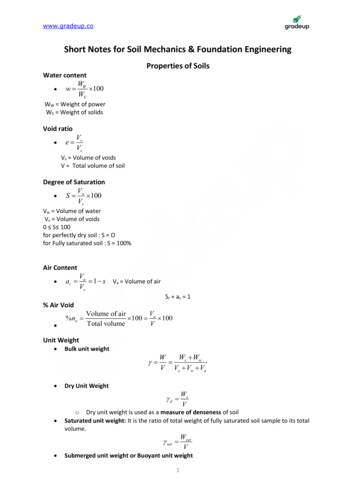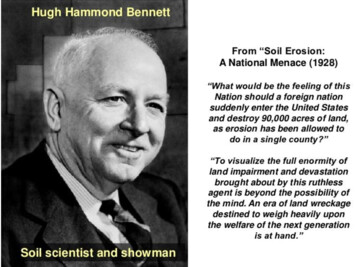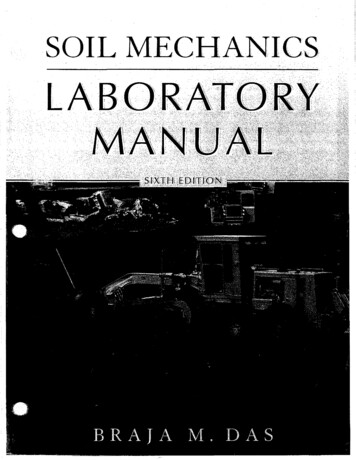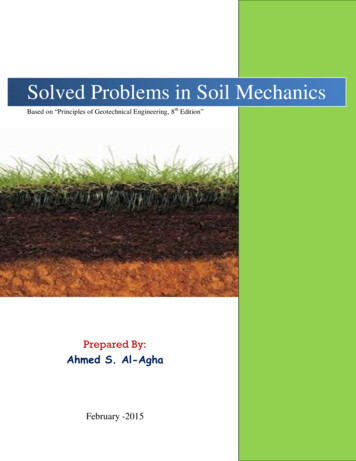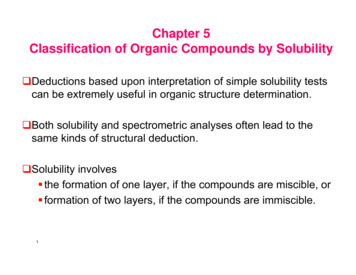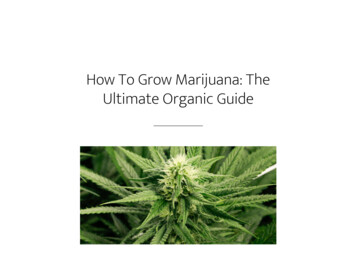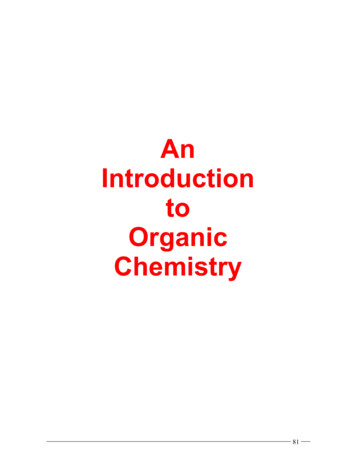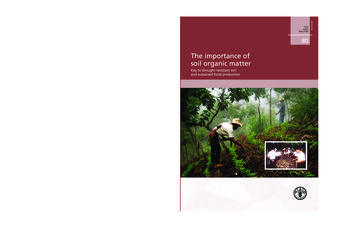
Transcription
FAO SOILS BULLETIN80Key to drought-resistant soiland sustained food productionSoil organic matter – the product of on-site biologicaldecomposition – affects the chemical and physicalproperties of the soil and its overall health. Its compositionand breakdown rate affect: the soil structure and porosity;the water infiltration rate and moisture holding capacityof soils; the diversity and biological activity of soilorganisms; and plant nutrient availability. This SoilsBulletin concentrates on the organic matter dynamicsof cropping soils and discusses the circumstances thatdeplete organic matter and their negative outcomes.It then moves on to more proactive solutions. It reviewsa “basket” of practices in order to show how they canincrease organic matter content and discusses the landand cropping benefits that then accrue.ISBN 92-5-105366-9789251ISSN 0253-2050053669TC/M/A0100E/1/10.05/1400FAO9The importance of soil organic matter — Key to drought-resistant soil and sustained food productionThe importance ofsoil organic matterThe importance ofsoil organic matterKey to drought-resistant soiland sustained food productionISSN 0253-20508080FAOSOILSBULLETIN
Cover photographs:Background: Honduras. FAO/18884/G. Bizzarri.Inset: Honduras. FAO/18907/G. Bizzarri.Copies of FAO publications can be requested from:SALES AND MARKETING GROUPInformation DivisionFood and Agriculture Organization of the United NationsViale delle Terme di Caracalla00100 Rome, ItalyE-mail: publications-sales@fao.orgFax: ( 39) 06 57053360Web site: http://www.fao.org
The importance ofsoil organic matterKey to drought-resistant soiland sustained food and productionbyAlexandra BotFAO ConsultantandJosé BenitesFAO Land and Plant NutritionManagement ServiceFOOD AND AGRICULTURE ORGANIZATION OF THE UNITED NATIONSRome, 2005FAOSOILSBULLETIN80
The designations employed and the presentation of material in this informationproduct do not imply the expression of any opinion whatsoever on the partof the Food and Agriculture Organization of the United Nations concerning thelegal or development status of any country, territory, city or area or of its authorities,or concerning the delimitation of its frontiers or boundaries.ISBN 92-5-105366-9All rights reserved. Reproduction and dissemination of material in this informationproduct for educational or other non-commercial purposes are authorized withoutany prior written permission from the copyright holders provided the source is fullyacknowledged. Reproduction of material in this information product for resale or othercommercial purposes is prohibited without written permission of the copyright holders.Applications for such permission should be addressed to:ChiefPublishing Management ServiceInformation DivisionFAOViale delle Terme di Caracalla, 00100 Rome, Italyor by e-mail to:copyright@fao.org FAO 2005
iiiContentsAcknowledgementsviiiPrefaceixList of acronymsxi1. Introduction12. Organic matter decomposition and the soil food web5Soil organic matter5The soil food web5Decomposition process7Non-humic substances: significance and functionCompounds and function of humus3. Natural factors influencing the amount of organic matter8811Temperature11Soil moisture and water saturation12Soil texture12Topography13Salinity and acidity13Vegetation and biomass production134. Practices that influence the amount of organic matter15Human interventions that influence soil organic matter15Practices that decrease soil organic matterDecrease in biomass productionReplacement of perennial vegetationReplacement of mixed vegetation with monoculture of crops andpasturesHigh harvest indexUse of bare fallowDecrease in organic matter supplyBurning of natural vegetation and crop residuesOvergrazingRemoval of crop residuesIncreased decomposition ratesTillage practicesDrainageFertilizer and pesticide use1515151616171717171718181919Practices that increase soil organic matter19Increased biomass production20Increased water availability for plants: water harvesting and irrigationBalanced fertilizationCover cropsImproved vegetative stands20212122
ivAgroforestry and alley croppingReforestation and afforestationRegeneration of natural vegetationIncreased organic matter supplyProtection from fireCrop residue managementUtilizing forage by grazing rather than by harvestingIntegrated pest managementApplying animal manure or other carbon-rich wastesCompostMulch or permanent soil cover2326272727272828282929Decreased decomposition rates30Reduced or zero tillage305. Creating drought-resistant soil35Effect of soil organic matter on soil properties35Inefficient use of rainwater35Increased soil moisture35Reduced soil erosion and improved water quality386. Key factors in sustained food production41Increased plant productivity41Increased fertilizer efficiency41Reduced waterlogging42Increased yields42Reduced herbicide and pesticide use44Increased biodiversity45Resilience467. The role of conservation agriculture in organic matterdeposition and carbon sequestration47Principles of conservation agriculture47Organic matter deposition47Increased carbon sequestration488. Conclusions51Bibliography53Annexes1. Soil organisms612. Effects of organic matter on soil properties71
vList of boxes1.Some functions of a healthy soil ecosystem62.Humic substances retain nutrients available on demand for plants93.Ways to increase organic matter contents4.Planting pits235.Examples of agroforestry systems worldwide246.Farmers' perceptions of the Quezungual system: benefits anddisadvantages25of soils207.Mulching in the highlands of northern Thailand318.Does improved organic matter management pay?439.Effect of different tillage practices on scarab beetle-grub holes andtheir volumes45
viList of figures1.Components of soil organic matter and their functions12.Carbon cycle53.Fluctuations in microbial biomass at different stages of crop developmentin conventional agriculture compared with systems with residue retentionand high organic matter input74.Closed cycle115.Composition of leaves and roots of leguminous and grass species146.Open cycle system157.Composition of soil macrofauna under primary forest, fallow, kudzu andgrass vegetation168.Evaluation of the organic matter content of a soil in Paraná209.Reduction of dry matter of different cover crops2210. Population size of root nodule bacteria with different crop rotations3211. Live and dead earthworm numbers per square metre at 0–15 cm of soildepth sampled immediately after treatment3312. Effect of amount of soil cover on rainwater runoff and infiltration3613. Water infiltration under different types of management3614. Quantity of water stored in the soil under conventional tillage andconservation agriculture3615. Effect of different soil covers on in-soil storage of water3716. Soil loss due to water erosion for different maize cropping systems3817. Development of water turbidity rates in the catchment area of Rio doCampo, Paraná, 1982–19993918. Temperature fluctuations at a soil depth of 3 cm in a cotton crop withand without a soil cover of mucuna3919. Effect of organic matter on soil pH4220. Maize yield under conventional tillage and direct sowing, with andwithout 90 kg of N fertilizer4421. Herbicide costs in different production systems in Lempira Sur, Honduras22. Organic matter content of a soil under different tillage management23. Soil carbon concentration at various soil depths affected by managementsystem444824. Effect of crop residue burning once every two years on soil carbon stock25. Estimation of emission and sequestration of CO2 (total over 8 years) underdifferent maize production systems with cover crops under direct sowingcompared with natural vegetation in southern Brazil4826. Potential for carbon sequestration in long-term experiment in southernBrazil484950
viiList of plates1.Crop residues added to the soil are decomposed by soil macrofaunaand micro-organisms, increasing the organic matter content of the soil.12.Termites create their own living conditions near their preferred foodsources. Inside the colony life is highly organized.63.Severe soil erosion removes the potential energy source for soilmicrobes, resulting in the death of the microbial population andthus of the soil itself.154.Clearance of primary forests often leads to rapid mineralization oforganic matter. This sandy soil used to sustain a tropical forest.165.The burning of residues is a common practice for clearing land, bothin slash-and-burn systems and in more intensive agricultural productionsystems.176.Animal at pasture in the area around Asmara.177.Removed crop residues cannot serve as food for soil organisms.188.Intensive soil tillage makes the land vulnerable to erosive processes,as the organic matter is lost through increased oxidation in the soil,the upper subsoil is compact, and the loosened topsoil can morereadily wash away.19Hollows are dug in the ground to gather water during the rainy season.219.10. Half-moons around newly planted Acacia seedlings catch and retainrainwater.2311. Agroforestry plot with suboptimal stand of maize because of shadingby trees.2412. Example of the “Quezungual” system, an indigenous agroforestry system.2513. Afforestation of “badlands” in the Niger.2614. Crop residue management by using a knife roller.2815. Farmer giving fodder to cattle2816. Preparation of compost made from discarded bits of fish and villagewaste. The compost plant is run by a cooperative of young people.2917. No-till maize under black oat mulch, Santa Catarina, Brazil3018. Farmer at work in a field of lettuces.3019. Mulching in the highlands of Northern Thailand.3120. “Frijol tapado” or broadcast beans on the residues of maize; a commonpractice in Latin America.3221. Maize seedling directly drilled in residues of wheat.3322. A sign on a farmgate in Australia. The farmer has achieved a workingcombination of zero tillage and controlled traffic and is reaping thebenefits of excellent water holding capacity in the soil, improved organicmatter status, more guaranteed harvests, and a more predictable andrewarding farming system.3323. Runoff and soil loss immediately after a rainstorm, Naisi catchment.Zomba Mountain, Malawi.3924. Under no-tillage conditions, the internal pore system of the soil is notdistroyed through land preparation activities and able to drain rainwaterfrom the surface to deeper layers (left). On bare soil the impact ofraindrops results in sealing of the surf42
viiiAcknowledgementsThis publication was prepared by Alexandra Bot, FAO consultant, and José Benites,technical officer, Land and Plant Nutrition Management Service (AGLL), FAO. Itis based on contributions from: Gunter Englisch, Germany; Anthony Juo of TexasA&M University, the United States of America; William Payne of the InternationalCrops Research Institute for the Semi-arid Tropics, Sahelien Centre, Niger; Maria deFátima Ribeiro dos Santos, Ademir Calegari and Francisco Skora Neto of Paraná StateAgricultural Research Station, Brazil.The authors would like to acknowledge the valuable comments provided by: ParvizKoohafkan, chief, AGLL; Sally Bunning, land management officer, AGLL; Juan Jimenez,consultant, AGLL; Alessandro Piccolo of the University of Naples; Francis Shaxon,consultant; Martin Bwalya of the African Conservation Tillage Network; Peter Brinn,consultant; Christian Pieri, consultant; Bob Stewart of Texas A&M University; NormanUphoff of the Cornell International Institute for Agricultural Development; RachidMrabet of the Institut National de la Recherche Agronomique Centre Aridoculture,Morocco; and Kurt Steiner of the German Agency for Technical Cooperation (GTZ).Invaluable help on draft versions of this document was provided by R. Brinkman,FAO consultant; Telmo Amado of the Federal University of Santa Maria, Brazil;and Des McGarry of Queensland Government, Australia. In the production of thispublication, the authors have been assisted effectively by Lynette Chalk.
ixPrefaceHealthy soil is the foundation of the food system. It produces healthy crops that inturn nourish people. Maintaining a healthy soil demands care and effort from farmersbecause farming is not benign. By definition, farming disturbs the natural soil processesincluding that of nutrient cycling – the release and uptake of nutrients.Plants obtain nutrients from two natural sources: organic matter and minerals.Organic matter includes any plant or animal material that returns to the soil and goesthrough the decomposition process. In addition to providing nutrients and habitat toorganisms living in the soil, organic matter also binds soil particles into aggregates andimproves the water holding capacity of soil. Most soils contain 2–10 percent organicmatter. However, even in small amounts, organic matter is very important.Soil is a living, dynamic ecosystem. Healthy soil is teeming with microscopic andlarger organisms that perform many vital functions including converting dead anddecaying matter as well as minerals to plant nutrients. Different soil organisms feedon different organic substrates. Their biological activity depends on the organic mattersupply.Nutrient exchanges between organic matter, water and soil are essential to soilfertility and need to be maintained for sustainable production purposes. Where thesoil is exploited for crop production without restoring the organic matter and nutrientcontents and maintaining a good structure, the nutrient cycles are broken, soil fertilitydeclines and the balance in the agro-ecosystem is destroyed.Soil organic matter – the product of on-site biological decomposition – affects thechemical and physical properties of the soil and its overall health. Its compositionand breakdown rate affect: the soil structure and porosity; the water infiltrationrate and moisture holding capacity of soils; the diversity and biological activity ofsoil organisms; and plant nutrient availability. Many common agricultural practices,especially ploughing, disc-tillage and vegetation burning, accelerate the decompositionof soil organic matter and leave the soil susceptible to wind and water erosion. However,there are alternative management practices that enhance soil health and allow sustainedagricultural productivity. Conservation agriculture encompasses a range of such goodpractices through combining no tillage or minimum tillage with a protective crop coverand crop rotations. It maintains surface residues, roots and soil organic matter, helpscontrol weeds, and enhances soil aggregation and intact large pores, in turn allowingwater infiltration and reducing runoff and erosion. In addition to making plant nutrientsavailable, the diverse soil organisms that thrive in such conditions contribute to pestcontrol and other vital ecological processes. Through combining pasture and fodderspecies and manuring with food and fibre crop production, mixed crop–livestocksystems also enhance soil organic matter and soil health. This document recognizes thecentral role of organic matter in improving soil productivity and outlines promisingtechnologies for improved organic matter management for productive and sustainablecrop production in the tropics.Soil organic matter content is a function of organic matter inputs (residues and roots)and litter decomposition. It is related to moisture, temperature and aeration, physicaland chemical properties of the soils as well as bioturbation (mixing by soil macrofauna),leaching by water and humus stabilization (organomineral complexes and aggregates).Land use and management practices also affect soil organic matter.Farming systems have tended to mine the soil for nutrients and to reduce soil organicmatter levels through repetitive harvesting of crops and inadequate efforts to replenish
xnutrients and restore soil quality. This decline continues until management practices areimproved or until a fallow period allows a gradual recovery through natural ecologicalprocesses. Only carefully selected diversified cropping systems or well-managed mixedcrop–livestock systems are able to maintain a balance in nutrient and organic mattersupply and removal.Farmers can take many actions to maintain, improve and rebuild their soils, especiallysoils that have been under cultivation for a long time. A key to soil restoration is tomaximize the retention and recycling of organic matter and plant nutrients, and tominimize the losses of these soil components caused by leaching, runoff and erosion.However, rebuilding soil quality and health through appropriate farming practices maytake several years, especially in dryland areas where limited moisture reduces biomassproduction and soil biological activity. Thus, the challenge is to identify soil managementpractices that promote soil organic matter formation and moisture retention and ensureproductivity and profitability for farmers in the short term.FAO recognizes that conservation agriculture can make an important contributionto the agriculture sector through its multiple environmental and economic benefits.Conservation agriculture uses holistic production management systems that promote andenhance agro-ecosystem health, including aboveground and belowground biodiversity,biological cycles, and biological activity. These systems apply specific and precisestandards of production based on no- or minimum-tillage techniques and selected covercrops and crop rotations. Their aim is to achieve optimal agro-ecosystems that are socially,ecologically and economically sustainable. Through effective harnessing of agro-ecologicalprocesses, conservation agriculture provides an opportunity for reducing external inputrequirements and for converting low-input agricultural systems into more productiveones. A better understanding of the linkages between soil life and ecosystem functionand the impact of human interventions will enable the reduction of negative impacts andthe more effective capture of the benefits of soil biological activity for sustainable andproductive agriculture.
xiList of acronymsAlAluminiumCCarbonCaCalciumCECCation exchange capacityCO2Carbon dioxideFeIronHHydrogenHYVHigh-yielding varietyKPotassiumMgMagnesiumNNitrogenNaOH Sodium aran AfricaTHMTrihalomethane
1Chapter 1IntroductionA.J. BOTOn the basis of organic matter content, soils are characterized as mineral or organic.Mineral soils form most of the world’s cultivated land and may contain from a trace to30 percent organic matter. Organic soils are naturally rich in organic matter principallyfor climatic reasons. Although they contain more than 30 percent organic matter, it isprecisely for this reason that they are not vital cropping soils.This soils bulletin concentrates on the organic matter dynamics of cropping soils. Inbrief, it discusses circumstances that deplete organic matter and the negative outcomesof this. The bulletin then moves on to more proactive solutions. It reviews a “basket” ofpractices in order to show how they can increase organic matter content and discussesthe land and cropping benefits that then accrue.Soil organic matter is any materialproduced originally by living organisms(plant or animal) that is returned to thesoil and goes through the decompositionprocess (Plate 1). At any given time, itconsists of a range of materials from theintact original tissues of plants and animalsto the substantially decomposed mixture ofmaterials known as humus (Figure 1).Most soil organic matter originatesfrom plant tissue. Plant residues contain60–90 percent moisture. The remainingdry matter consists of carbon (C), oxygen,hydrogen (H) and small amounts of sulphur(S), nitrogen (N), phosphorus (P), potassium Plate 1Crop residues added to the soil are decomposed by(K), calcium (Ca) and magnesium (Mg). soil macrofauna and micro-organisms, increasing theAlthough present in small amounts, these organic matter content of the soil.nutrients are very important from theviewpoint of soil fertility management.Soil organic matter consists of a varietyFIGURE 1of components. These include, in varyingComponents of soil organic matter and theirproportions and many intermediate stages,functionsan active organic fraction including microSoil organic matterorganisms (10–40 percent), and resistant orstable organic matter (40–60 percent), alsoreferred to as humus.Living organismsPartially decomposed plantSoil engineand animal residuesForms and classification of soil organicmatter have been described by Tate (1987) andTheng (1987). For practical purposes, organicUnaltered materialPotential food of organismsmatter may be divided into aboveground andTransformed productsbelowground fractions. Aboveground organicmatter comprises plant residues and animalNon-humic substancesHumic substancesresidues; belowground organic matter consistsFood and energyNutrient bank"Glue"Bufferof living soil fauna and microflora, partiallydecomposed plant and animal residues, andhumic substances. The C:N ratio is also used
2The importance of soil organic matterto indicate the type of material and ease of decomposition; hard woody materials with ahigh C:N ratio being more resilient than soft leafy materials with a low C:N ratio.Although soil organic matter can be partitioned conveniently into different fractions,these do not represent static end products. Instead, the amounts present reflect a dynamicequilibrium. The total amount and partitioning of organic matter in the soil is influencedby soil properties and by the quantity of annual inputs of plant and animal residues tothe ecosystem. For example, in a given soil ecosystem, the rate of decomposition andaccumulation of soil organic matter is determined by such soil properties as texture,pH, temperature, moisture, aeration, clay mineralogy and soil biological activities. Acomplication is that soil organic matter in turn influences or modifies many of these samesoil properties.Organic matter existing on the soil surface as raw plant residues helps protect thesoil from the effect of rainfall, wind and sun. Removal, incorporation or burning ofresidues exposes the soil to negative climatic impacts, and removal or burning deprivesthe soil organisms of their primary energy source.Organic matter within the soil serves several functions. From a practical agriculturalstandpoint, it is important for two main reasons: (i) as a “revolving nutrient fund”; and(ii) as an agent to improve soil structure, maintain tilth and minimize erosion.As a revolving nutrient fund, organic matter serves two main functions:ÿ As soil organic matter is derived mainly from plant residues, it contains all of theessential plant nutrients. Therefore, accumulated organic matter is a storehouse ofplant nutrients.ÿ The stable organic fraction (humus) adsorbs and holds nutrients in a plantavailable form.Organic matter releases nutrients in a plant-available form upon decomposition. Inorder to maintain this nutrient cycling system, the rate of organic matter addition fromcrop residues, manure and any other sources must equal the rate of decomposition, andtake into account the rate of uptake by plants and losses by leaching and erosion.Where the rate of addition is less than the rate of decomposition, soil organic matterdeclines. Conversely, where the rate of addition is higher than the rate of decomposition,soil organic matter increases. The term steady state describes a condition where the rateof addition is equal to the rate of decomposition.In terms of improving soil structure, the active and some of the resistant soil organiccomponents, together with micro-organisms (especially fungi), are involved in bindingsoil particles into larger aggregates. Aggregation is important for good soil structure,aeration, water infiltration and resistance to erosion and crusting.Traditionally, soil aggregation has been linked with either total C (Matson et al.,1997) or organic C levels (Dalal and Mayer, 1986a, 1986b). More recently, techniqueshave developed to fractionate C on the basis of lability (ease of oxidation), recognizingthat these subpools of C may have greater effect on soil physical stability and be moresensitive indicators than total C values of carbon dynamics in agricultural systems(Lefroy, Blair and Strong, 1993; Blair, Lefroy and Lisle, 1995; Blair and Crocker, 2000).The labile carbon fraction has been shown to be an indicator of key soil chemical andphysical properties. For example, this fraction has been shown to be the primary factorcontrolling aggregate breakdown in Ferrosols (non-cracking red clays), measured bythe percentage of aggregates measuring less than 0.125 mm in the surface crust aftersimulated rain in the laboratory (Bell et al., 1998, 1999).The resistant or stable fraction of soil organic matter contributes mainly to nutrientholding capacity (cation exchange capacity [CEC]) and soil colour. This fraction oforganic matter decomposes very slowly. Therefore, it has less influence on soil fertilitythan the active organic fraction.Chapters 2 and 3 deal with the transformation of organic matter by soil organismsand with natural factors influencing the level of organic matter content in the soil.
Chapter 1 – IntroductionChapter 4 discusses the various management practices that affect the accumulation oforganic matter in the soil. Chapter 5 examines how to create drought-resistant soil,while Chapter 6 explores various aspect of sustained food production. Chapter 7examines the role of conservation agriculture, and Chapter 8 presents the conclusions.Annex 1 provides background information on the different soil organisms ofimportance in agriculture. Annex 2 provides details of the effects of organic matter onbiological, chemical and physical soil properties.3
5Chapter 2Organic matter decomposition andthe soil food webSOIL ORGANIC MATTERWhen plant residues are returned to thesoil, various organic compounds undergoFIGURE 2decomposition. Decomposition is a biologicalCarbon cycleprocess that includes the physical breakdownCropand biochemical transformation of complex Micro-organismsresiduesand soil biotaDecompositionorganic molecules of dead material intoCropMicro-organismsand soil biotasimpler organic and inorganic moleculesNutrients(Juma, 1998).OxygenHumusCO 2 H 2 OThe continual addition of decaying plantresidues to the soil surface contributes to theMineralizationbiological activity and the carbon cyclingImmobilizationprocess in the soil. Breakdown of soil organicProteins andmatter and root growth and decay alsopolysaccharidescontribute to these processes. Carbon cyclingSoilis the continuous transformation of organicstructureand inorganic carbon compounds by plantsand micro- and macro-organisms betweenthe soil, plants and the atmosphere (Figure 2).Decomposition of organic matter is largely a biological process that occurs naturally.Its speed is determined by three major factors: soil organisms, the physical environmentand the quality of the organic matter (Brussaard, 1994). In the decomposition process,different products are released: carbon dioxide (CO2), energy, water, plant nutrientsand resynthesized organic carbon compounds. Successive decomposition of deadmaterial and modified organic matter results in the formation of a more complexorganic matter called humus (Juma, 1998). This process is called humification. Humusaffects soil properties. As it slowly decomposes, it colours the soil darker; increases soilaggregation and aggregate stability; increases the CEC (the ability to attract and retainnutrients); and contributes N, P and other nutrients.Soil organisms, including micro-organisms, use soil organic matter as food. As theybreak down the organic matter, any excess nutrients (N, P and S) are released into thesoil in forms that plants can use. This release process is called mineralization. The wasteproducts produced by micro-organisms are also soil organic matter. This waste materialis less decomposable than the original plant and animal material, but it can be used bya large number of organisms. By breaking down carbon structures and rebuilding newones or storing the C into their own biomass, soil biota plays the most important rolein nutrient cycling processes and, thus, in the ability of a soil to provide the crop withsufficient nutrients to harvest a healthy product. The organic matter content, especiallythe more stable humus, increases the capacity to store water and store (sequester) Cfrom the atmosphere.THE SOIL FOOD WEBThe soil ecosystem (Box 1) can be defined as an interdependent life-support systemcomposed of air, water, minerals, organic matter, and macro- and micro-organisms,
The importance of soil organic matter6all of which function together and interactclosely.Some functions of a healthy soil ecosystemThe organisms and their interactionsenhance many soil ecosystem functions Decompose organic matter towards humus.and make up the soil food web. The energy Retain N and other nutrients.needed for all food webs is generated by Glue soil particles together for best structure.primary producers: the plants, lichens, Protect roots from diseases and parasites.moss, photosynthetic bacteria and algae Make retained nutrients available to the plant.that use sunlight to transform CO2 from the Produce hormones that help plants grow.atmosphere into carbohydrates. Most other Retain water.organisms depend on the primary producersfor their energy and nutrients; they are calledconsumers.Soil life plays a major role in many natural processes that determine nutrient andwater availability for agricultural productivity. The primary activities of all livingorganisms are growing and reproducing. By-products from growing roots and plantresidues feed soil organisms. In turn, soil organisms support plant health as theydecompose organic matter, cycle nutrients, enhance soil structure and control thepopulations of soil organisms, both beneficial and harmful (pests and pathogens) interms of crop productivity.
Effect of organic matter on soil pH 42 20. Maize yield under conventional tillage and direct sowing, with and without 90 kg of N fertilizer 44 21. Herbicide costs in different production systems in Lempira Sur, Honduras 44 22. Organic matter co




